Test – Powercolor R9 280X: Specs | Price | CPU | Profitability| Hashrate| best Coins | Config | Advantage (Pros) and Disadvantages (Cons) and other important features that will help you make better decision.
Hi all!
In the series of R9 280X cards from AMD I am going to present the Powercolor R9 280X to you today! Powercolor is not a newcomer in the world of graphics cards because the brand has existed since 1997 but is not very widespread in France unfortunately, it is time to change that and give a little look to one of their cards!
Specification: Powercolor R9 280X
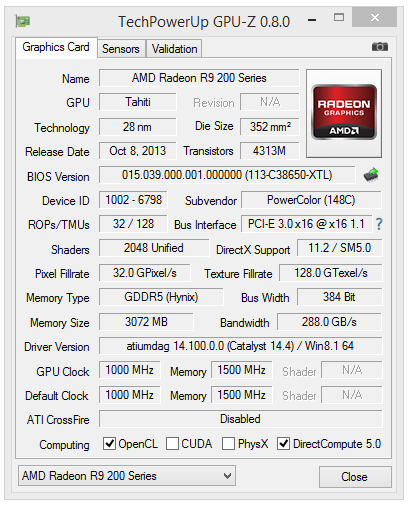
Hashrate: Powercolor R9 280X
| Powercolor R9 280X | |
|---|---|
| GPU | Tahiti |
| GPU frequency | 850MHz 1000 Mhz Boost |
| Memory Frequency | 1500 Mhz |
| Amount of memory | 3 Go de DDR5 |
| Memory bus | 384 bit |
| Connectivity | 2 x DVI-I 1 x HDMI 2 x mini Display Port |
| Dimensions | 26,6 x 11,1 x 3,8 cm |
| Food | 1 x 6-pin 1 x 8-pin |
| Price | ~ 230€ |
| Guarantee | 2 years |
As we can see the characteristics of the Powercolor R9 280X do not really change from the other cards, the dimensions are however rather contained with “only” 26.6cm in length and 11.1 in height. The presence of 6-pin and 8-pin connectors for the power supply show that the card will certainly not consume less than the other R9 280X, which is quite normal. There is still a small change on the Powercolor R9 280X, the presence of 2 x mini Diplay port in addition to the 1 x DVI and 1 x HDMI present, when the competitors in general opt for 2 x DVI 1 x HDMI and 1 x mini display port.
Offered at around 230 € the price is contained and should be a plus if the card proves to be silent under load, we will see all of this during the tests!

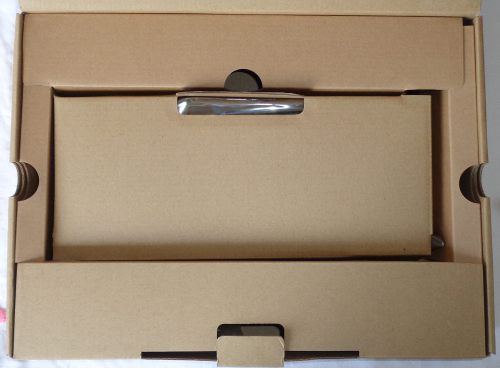
The card was delivered to me in its box but without the cover, so a classic box with compartments inside to keep the card in place in addition to protecting it from shocks. The bundle is in the lower compartment.
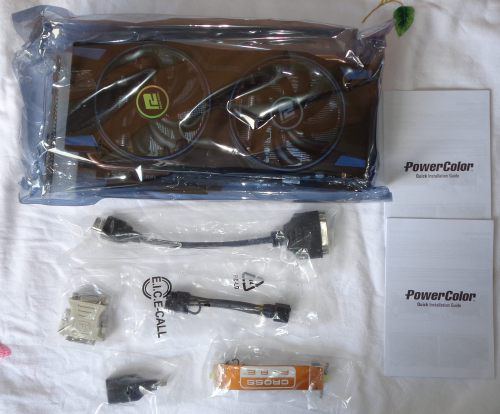
The bundle is made up of:
- 1 pont Crossfire
- 1 6-pin -> 8-pin adapter
- 1 DVI -> VGA adapter
- 1 mini DisplayPort adapter -> DisplayPort
- 1 DVI -> HDMI adapter
- 1 CD of drivers (not in my box)
- Manuals
As we can see the bundle is rather very well supplied with adapters in all directions which will be very useful when using in multi-screens.
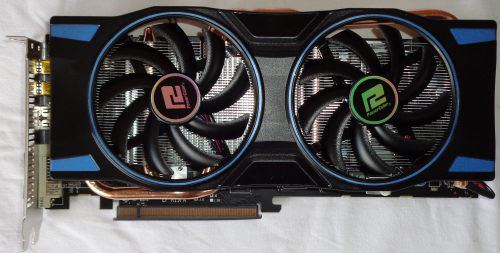
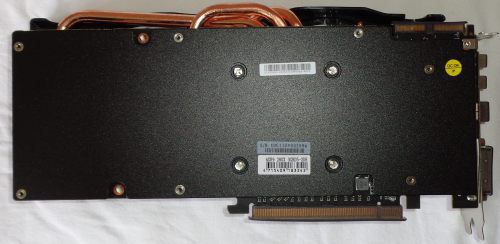
Here is the beast! A fairing of a black and blue plastic block and equipped with 2 fans of 8.5 cm, the build quality is quite good. At the back we find a metal plate attached to different places which will have the effect of strengthening the card, which is a very good thing when we know the tendency to twist these cards there in addition to adding a look un little nicer than a simple PCB.


On the edge we can see the back plate of the card separated from it by spacers, the rigidity will certainly not be lacking in the Powercolor R9 280X. You can also see that the cooling of the VRMs is provided by an independent heatsink, which is always a very good thing when you want to change the original cooling system (more information on changing the cooling here).
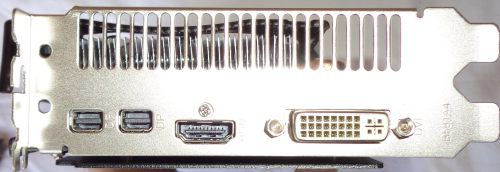
Hi all!
As I said a little above the connection of the Powercolor R9 280X is a little atypical compared to other R9 280X on the market with 2 mini-DP ports, 1 HDMI port and a DVI port which occupy only 1 slot, the other slot is entirely reserved for the evacuation of air.

The power is entrusted to 1 PCIe 6-pin port and 1 PCIe 8-pin port, nothing out of the ordinary for an R9 280X.
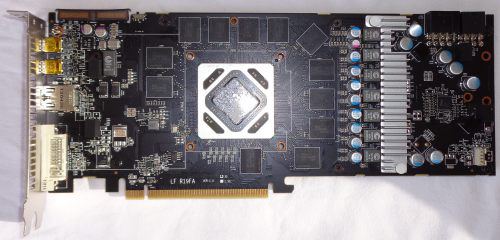
Here is the beast laid bare! As we can see the memory chips are not directly cooled by a heatsink but only by the blast of the fans of the card, this should not normally be a problem for original use but perhaps when overclocking , we will see that! The card is from AMD’s benchmark design and therefore shouldn’t differ much in overclocking from the MSI R9 280X Gaming OC I tested here.
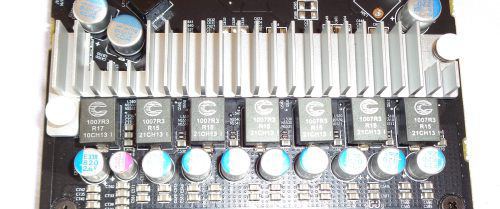
As I said the VRMs are cooled by an independent radiator which is made of aluminum.
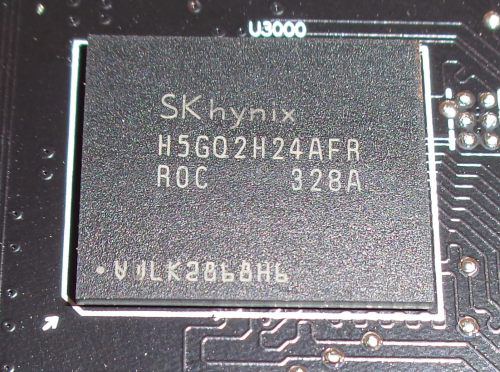
The memory is entrusted to Hynix with the famous H5GQ2H24FR R0C which are given to run at 1500Mhz, the same frequency as the test card.
The test platform
The configuration used during the tests is as follows:
- Processeur: Intel Core i5 4670K @ 4 Ghz
- Motherboard : Gigabyte Z87-UD5H TH
- Mémoire: Kingston HyperX 4 x 2 Go 1600Mhz
- Disque dur: WD Raptor 150 Go
- Power supply : Seasonic X650
- Drivers: Catalyst 14.4 (AMD) & GeForce 337.88 (nVidia)
- Operating system : Windows 8.1 64bits
All games will be tested in 1920 × 1080 detail in full detail (except the TressFX on Tomb Raider), which is the current ‘standard’, graphics cards used in testing are as follows:
- Powercolor R9 280X
- XFX R9 290 Double Dissipation (tested here)
- XFX R9 285 Black Edition (tested here)
- MSI R9 290 Gaming OC 4GB (tested here)
- HIS R9 290 iPower IceQ X² OC 4GB (testée ici)
- XFX R9 280 Double Dissipation (tested here)
- Sapphire 7950 Dualx @ 900Mhz
- Sapphire 7970 Ghz Edition
- MSI R9 280X Gaming (tested here)
- Asus GTX770 DirectCU OC
Consumption / Temperature
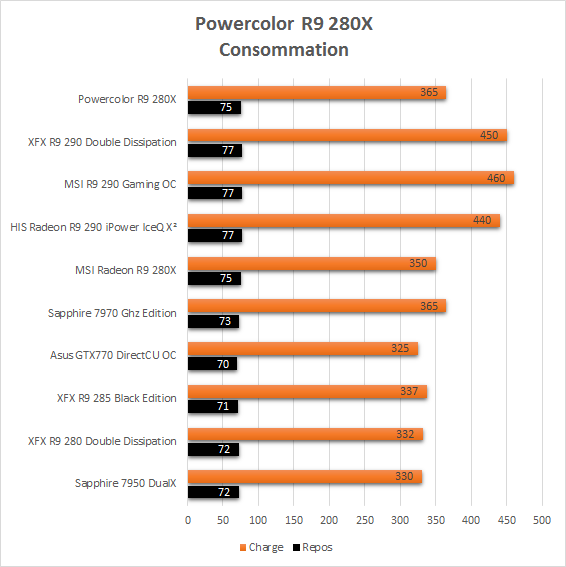
The consumption test was carried out under OCCT Power Supply which makes it possible to push the consumption of the components to the maximum, note that this value reflects the total consumption at the outlet of the machine and not the graphics card itself!
The power consumption of the Powercolor R9 280X is identical to 7970 Ghz Edition, not surprising when seeing that the frequencies of the 2 cards are exactly the same. With 365 Watts in load, consumption is rather measured, we are quite far from the R9 290.
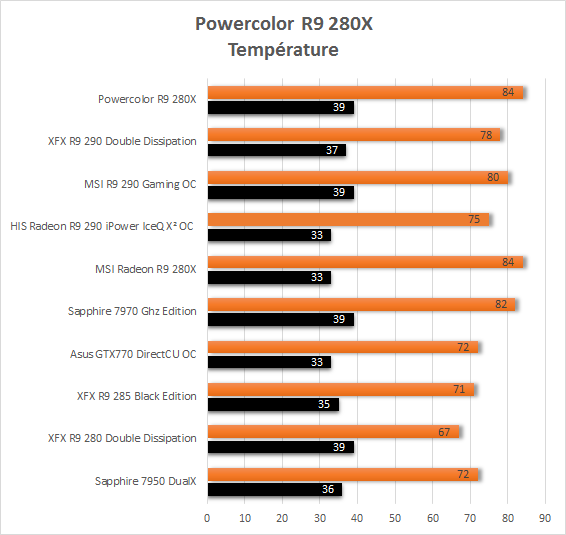
Once again we are within the standards of 7970 GH edition R9 280X with 39 ° at rest for 84 ° under load, nothing out of the ordinary, the GPU is fairly well cooled.
Sound level
Warning: Part to be taken with a grain of salt, unfortunately not having access to the appropriate equipment and using an android application to take the readings The measurements below are only indicative! The readings were taken 20cm from the graphics card.

In terms of noise pollution, the Powercolor R9 280X is simply excellent, with 32dB at rest it will be inaudible in a closed box and with 37dB in load the other components of the PC will certainly make more noise than it. Only a very slight friction noise is heard with the ear glued to the fans that we hear more at 30cm.
Powertune
To get started, let’s take a look at the Powertune that powers the R9 280X. Powertune is responsible for maintaining the temperature of the processor, the consumption of the card below certain values. During overclocking it is mandatory to be able to modify all the possible settings in order to get the best performance, for Powertune and the R9 280X series it is possible to increase the consumption limit of the card by 20% (50% for the R9 290 / 290X). There will be 2 different tests:
- OCCT with factory settings
- OCCT with factory settings + 20% at consumption limit
OCCT Factory :

Without increasing the consumption limit, Powertune is very aggressive on the Powercolor R9 280X and puts the GPU frequency to its minimum, namely 850Mhz, which is far from the 1000Mhz of Boost. Let’s see how Powertune behaves if we increase the consumption limit by 20%:
OCCT + 20% Consumption :

This is done, if the consumption limit is unbridled by 20%, the Powercolor R9 280X holds the 1000Mhz on OCCT without flinching.
3DMark Fire Strike
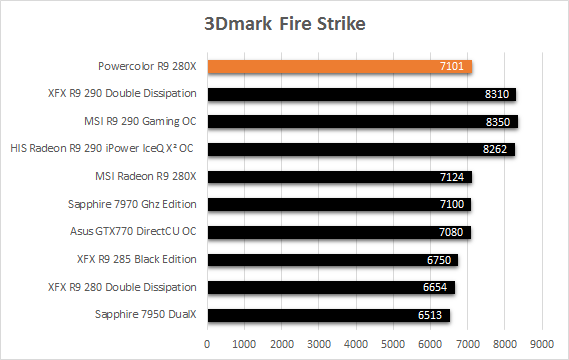
Battlefield 4

Bioshock Infinite

Crysis 3

Hitman Absolution
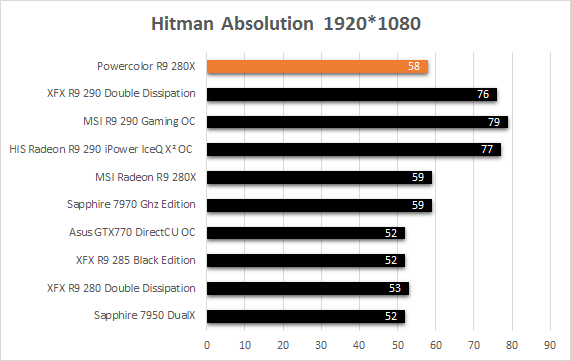
Tomb Raider
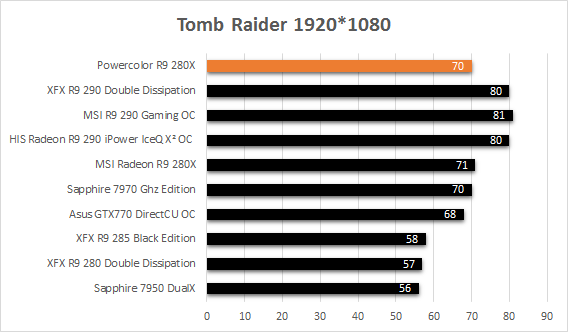
Summary of performance
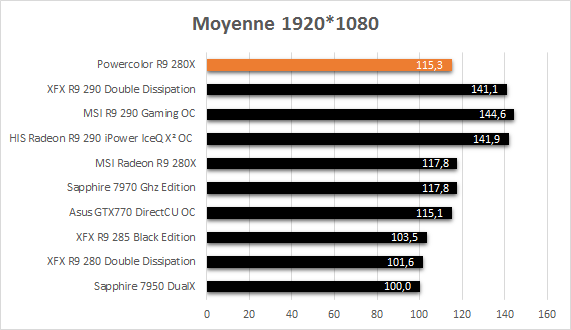
Not really a big change when it comes to gaming, the MSI R9 280X and Sapphiure 79790 GHz Edition are all neck and neck with the Powercolor R9 280X. What we can learn from all of this is that the AMD R9 280X GPU is quite capable of running games in excellent conditions at 1920 × 1080, although the R9 290s are still far more capable.
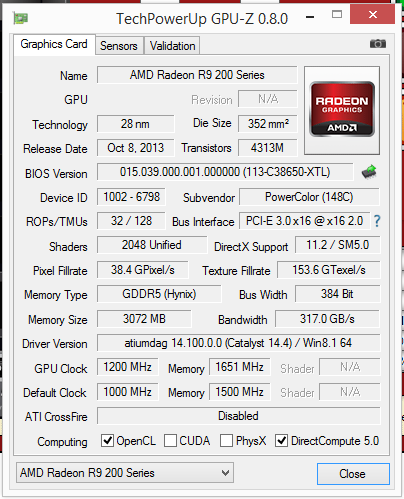
The maximum overclocking achieved, with the help of the 20% additional consumption is:
- GPU: 1200 Mhz (+200 Mhz)
- Memory : 1650 Mhz (+ 150 Mhz)
The Powercolor was rather docile in overclocking with the original voltages with 1200MHz for the GPU (+ 20%) and 1650Mhz for the memory (+ 10%), excellent results! On the other hand, the slightest increase in voltage caused crashes whether in memory or in the GPU, so we will stay at the original voltages for the tests.
Consumption

Overclocking leads to a hell of an increase in consumption, going from 365 Watts to 473 Watts in load (I remind you that this is the total consumption of the machine at the outlet) which is still 108 Watts more! We have nothing for nothing that said and overclocking necessarily leads to this kind of overflow 😉
Temperature
At the temperature level I took several readings, namely one for the factory Powercolor R9 280X which will serve as a reference, 1 for the factory frequencies with unbridled consumption of 20%, 1 for the Overclocked card with the fans managed by the card and 1 for the overclocked card with maximum fans. Why 2 temperature readings in overclocking? Well quite simply because with the fans managed by the Powertune card activated because of the excessive temperature of the VRMs and lowered the frequency of the GPU, we will see that below!
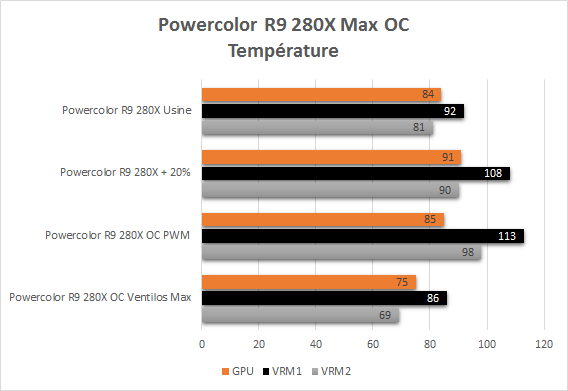
Originally, the temperatures of the GPU and VRMs are quite good with 84 ° for the GPU and 92 ° / 81 ° for the VRMs. Once the unbridled consumption limit we clearly see a significant increase in temperatures, we go to 91 ° for the GPU and 108 ° / 90 ° for the VRMs, nothing abnormal in itself but it is starting to get hot for these small chips .
Once overclocking is applied, on the other hand, we can clearly see that something is wrong, in fact the GPU only reaches 85 ° (whereas it was 91 ° with the original frequencies), why?
Because VRMs get too hot! 113 ° and Powertune comes to put its nose in by lowering the operating frequency of the GPU and therefore the heating of the latter is less. Once the fans are set to maximum all the temperatures return to order and there are no more problems, on the other hand as we will see below the noise pollution is quite different!
Sound level
Warning: Part to be taken with a grain of salt, unfortunately not having access to the appropriate equipment and using an android application to take the readings The measurements below are only indicative! The readings were taken 20cm from the graphics card.

Once overclocking is activated, the sound level only drops from 37 dB to 40 dB, which is still very good even if the difference can be heard in the ear but as we will see just below the silence is paid at the level performance because Powertune goes through here and lowers the GPU frequency. Once the fans are at their maximum the noise pollution is quite different with 51 dB, there the noise quickly becomes annoying, so you will have to be very careful with the ventilation settings if you want to overclock the Powercolor R9 280X.
Powertune
What will our little Powertune say with the overclocking of the Powercolor R9 280X? Let’s see this under OCCT:
OCCT with PWM fans :

As we can see here Powertune engages at regular intervals and lowers the frequency of the card to around 500Mhz, which has a significant impact on performance as you can imagine! The 113 ° of the VRM1 probe is the cause, let’s see what it gives once the fans are set to maximum.
OCCT with fans at max :

And here is the problem is solved, no more drop in the frequency of the GPU, the temperatures are now very good.
Results
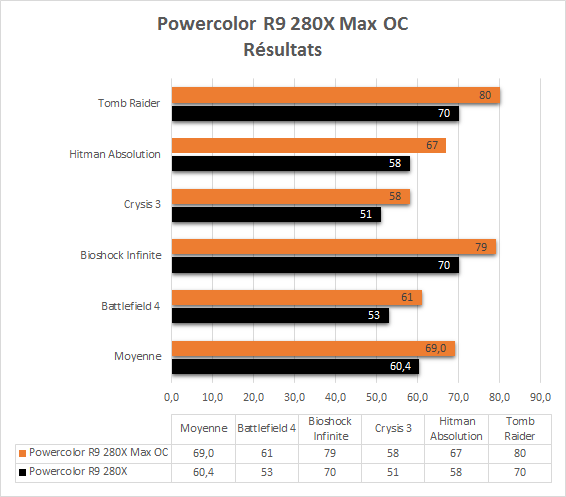
Overclocking does wonders on performance and we go from an average of 60.4 FPS in the games tested today to 69 FPS or a gain of around 14%, that’s not nothing!
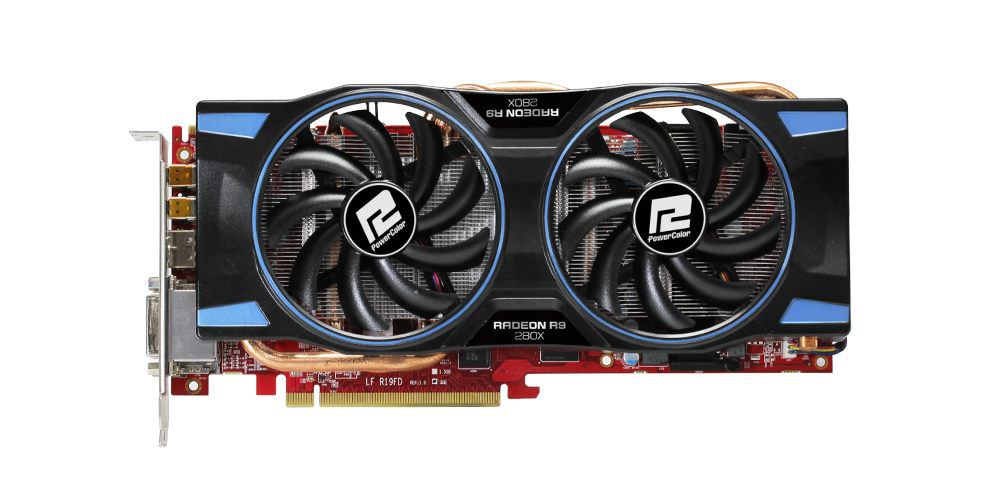
Here we are at the end of this test, what to say about the Powercolor R9 280X?
The build quality is very good, the performances are there and very sufficient for the current games in 1920 x 1080. In terms of the sound level it is very good original with a card which will be very silent, that whether at rest or under load, it will not hurt your ears!
The overclocking potential of the card that I had in my hands is very interesting with I recall 20% increase in GPU and 10% in memory, which is reflected in performance.
The only small spot in this table is the behavior of the original ventilation during overclocking, indeed it will be good practice to modify the ventilation curve by hand during extensive overclocking otherwise you will have a drop. performance each time the VRMs reach a certain temperature.
Offered at around € 230, the Powercolor R9 280X will be a very good card for a gamer config if you are looking for performance and silence at a reasonable price.
Advantages
- Performances
- Overclocking
- Silence
- Price
Disadvantages
- Fan curve during overclocking
A big thank you to Yann from Text100 and AMD who allowed me to do this test.















